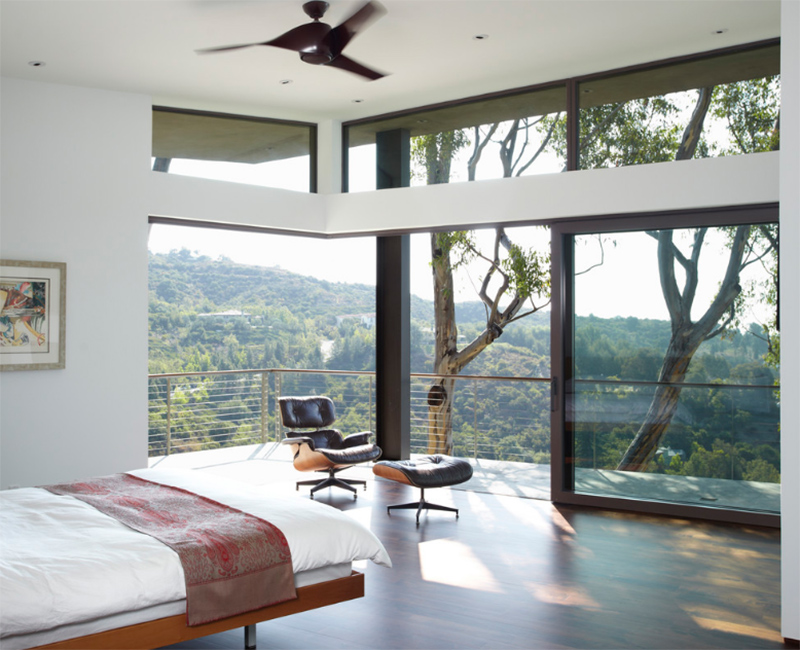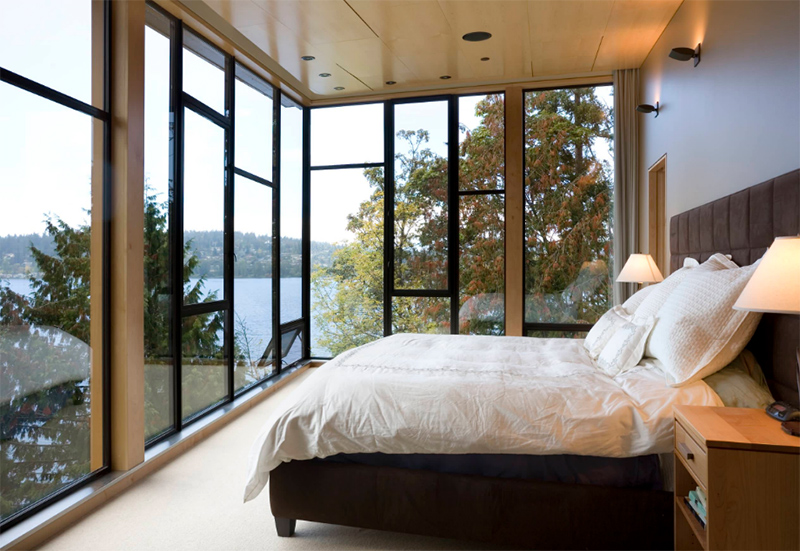Benefits of Floor-to-Ceiling Windows in Bedrooms

Floor-to-ceiling windows are becoming increasingly popular in modern homes, and for good reason. They offer a unique blend of style and functionality, transforming bedrooms into light-filled sanctuaries. These expansive windows not only enhance the aesthetics of a space but also contribute to a more comfortable and fulfilling living experience.
The Impact of Natural Light on Sleep Quality and Mood
Natural light plays a crucial role in regulating our circadian rhythm, the natural sleep-wake cycle that governs our body’s functions. Exposure to sunlight during the day helps to suppress melatonin production, a hormone that promotes sleepiness. As the sun sets, our bodies naturally start to produce melatonin, preparing us for restful sleep.
Floor-to-ceiling windows allow for ample natural light to flood the bedroom during the day, promoting alertness and boosting mood. In the evening, the gradual dimming of natural light signals the body to start producing melatonin, making it easier to fall asleep at night. This natural light cycle helps to create a more balanced sleep schedule, leading to improved sleep quality and a more energized and positive outlook throughout the day.
The Connection Between Views and Well-Being
Studies have shown that exposure to nature can have a significant impact on mental and physical health. The beauty of a natural view can have a calming effect, reducing stress and anxiety.
Floor-to-ceiling windows provide an uninterrupted connection to the outside world, offering a panoramic view of the surrounding landscape. Whether it’s a bustling cityscape or a serene garden, the visual stimulation can be a source of inspiration and tranquility. The feeling of being connected to nature can enhance feelings of well-being and create a more peaceful and relaxing atmosphere in the bedroom.
Floor-to-Ceiling Windows in Smaller vs. Larger Bedrooms
Floor-to-ceiling windows can be particularly beneficial in smaller bedrooms, where maximizing natural light is crucial. The expansive view creates an illusion of space, making the room feel larger and more airy.
In larger bedrooms, floor-to-ceiling windows can be used to create a dramatic and luxurious feel. The abundance of natural light can highlight the architectural features of the room, creating a sense of grandeur and sophistication.
Design Tips for Maximizing Natural Light and Minimizing Heat Gain
While floor-to-ceiling windows offer numerous advantages, it’s important to consider their impact on energy efficiency. To maximize natural light while minimizing heat gain, consider these design tips:
- Choose the Right Glass: Opt for low-emissivity (low-e) glass, which reflects heat away from the room during the summer while allowing light to pass through.
- Install Window Treatments: Use blinds, curtains, or shades to control the amount of sunlight entering the room. Light-colored fabrics can reflect heat, while darker fabrics can absorb it.
- Maximize Natural Ventilation: Consider installing operable windows or skylights to allow for cross-ventilation, which can help to cool the room naturally.
Design Considerations for Floor-to-Ceiling Windows in Bedrooms: Floor To Ceiling Windows In Bedroom

Floor-to-ceiling windows are a popular design element in modern homes, but they can present some unique challenges when it comes to decorating your bedroom. These windows can create a sense of openness and connection to the outdoors, but they also require careful consideration of privacy, light control, and overall aesthetic.
Window Treatments for Floor-to-Ceiling Windows, Floor to ceiling windows in bedroom
The right window treatment can make or break the look of your bedroom with floor-to-ceiling windows. It’s crucial to choose something that complements your design aesthetic while providing the necessary level of privacy and light control.
Here are some popular options:
- Sheer Curtains: Sheer curtains offer a delicate and airy feel, allowing natural light to filter through while still providing some privacy. They can be layered with heavier drapes for more privacy at night.
- Blinds: Blinds are a practical and versatile option for light control. They come in various materials, colors, and styles, allowing you to choose the perfect fit for your bedroom.
- Drapes: Drapes offer the most privacy and light control, and they can add a touch of elegance to your bedroom. They are available in a wide range of fabrics and styles, so you can find the perfect option to complement your decor.
Comparing Privacy Levels of Window Treatments
Privacy is a major concern when it comes to floor-to-ceiling windows, especially in bedrooms. Here’s a table comparing the privacy levels offered by different window treatments:
| Window Treatment | Privacy Level |
|---|---|
| Sheer Curtains | Low |
| Blinds | Medium |
| Drapes | High |
Bedroom Layout with Floor-to-Ceiling Windows
Maximizing the use of floor-to-ceiling windows in your bedroom involves thoughtful furniture placement and lighting. Here’s a layout suggestion:
– Furniture Placement: Place your bed against the wall opposite the windows to enjoy the view while lying down. Consider using a chaise lounge or a comfortable armchair near the windows for reading or relaxing.
– Lighting: Use a combination of natural and artificial light. Floor lamps or sconces placed strategically around the room can create a warm and inviting ambiance. Consider using dimmer switches to adjust the lighting level as needed.
Practical Considerations for Floor-to-Ceiling Windows in Bedrooms

Floor-to-ceiling windows in bedrooms offer stunning views and a sense of openness, but they also present practical considerations that require careful planning and attention. You’ll want to consider energy efficiency, safety, and maintenance to ensure these windows enhance your living experience.
Energy Efficiency and Heat Gain/Loss
Floor-to-ceiling windows can significantly impact a bedroom’s energy efficiency, leading to higher heating and cooling costs if not addressed properly.
- Heat Gain: During summer, these large windows can allow excessive sunlight to enter, increasing the room’s temperature and making it uncomfortable. This can lead to higher energy consumption for air conditioning.
- Heat Loss: In winter, the same large surface area can result in heat loss, making the room colder and requiring more energy for heating.
Types of Glazing for Insulation and Glare Reduction
To mitigate the effects of heat gain and loss, choosing the right glazing is crucial.
- Low-Emissivity (Low-E) Glass: Low-E coatings are applied to the glass surface to reflect infrared radiation, reducing heat transfer. This helps minimize heat gain in summer and heat loss in winter.
- Double- or Triple-Pane Windows: Multiple panes of glass with an insulating gas (like argon or krypton) trapped between them create a barrier that reduces heat transfer and improves sound insulation.
- Tinted or Reflective Glass: These options help reduce glare and heat gain by filtering out some of the sun’s rays.
Safety Measures for Floor-to-Ceiling Windows in Bedrooms with Children
With large, expansive windows, safety becomes a paramount concern, especially when children are present.
- Window Guards: Installing window guards, either fixed or removable, can prevent accidental falls, especially from higher floors.
- Window Locks: Use window locks that prevent children from opening windows beyond a safe distance.
- Window Film: Safety film can be applied to windows to help prevent shattering in case of impact, reducing the risk of injury.
Maintenance Tips for Floor-to-Ceiling Windows
Regular maintenance is essential to keep your floor-to-ceiling windows in optimal condition and ensure their longevity.
- Cleaning: Clean windows regularly with a mild detergent and soft cloth. Avoid abrasive cleaners that can scratch the glass.
- Check for Leaks: Inspect windows for any leaks around the frame or seals. If leaks are found, address them promptly to prevent water damage.
- Lubricate Hardware: Lubricate window handles, hinges, and other moving parts regularly to ensure smooth operation.
- Inspect for Damage: Regularly inspect windows for any cracks, chips, or other damage. Repair or replace damaged components promptly to prevent further deterioration.
Floor to ceiling windows in bedroom – Floor-to-ceiling windows in a bedroom can transform the space, flooding it with natural light and creating a sense of openness. However, if you’re dealing with a small bedroom, maximizing space and light becomes even more crucial. Consider incorporating sliding glass doors, as seen in this small bedroom with sliding glass doors , to create a seamless transition to an outdoor area and further enhance the sense of spaciousness.
By incorporating these design elements, you can enjoy the benefits of floor-to-ceiling windows even in a compact bedroom.
Floor-to-ceiling windows in a bedroom can be a stunning design element, but they can also pose a challenge when it comes to furniture placement. A queen-sized bed, especially in a smaller bedroom, can feel overwhelming. To maximize space and style, consider a queen bed frame for small bedroom that features a low profile or sleek design, allowing the windows to remain the focal point of the room.
